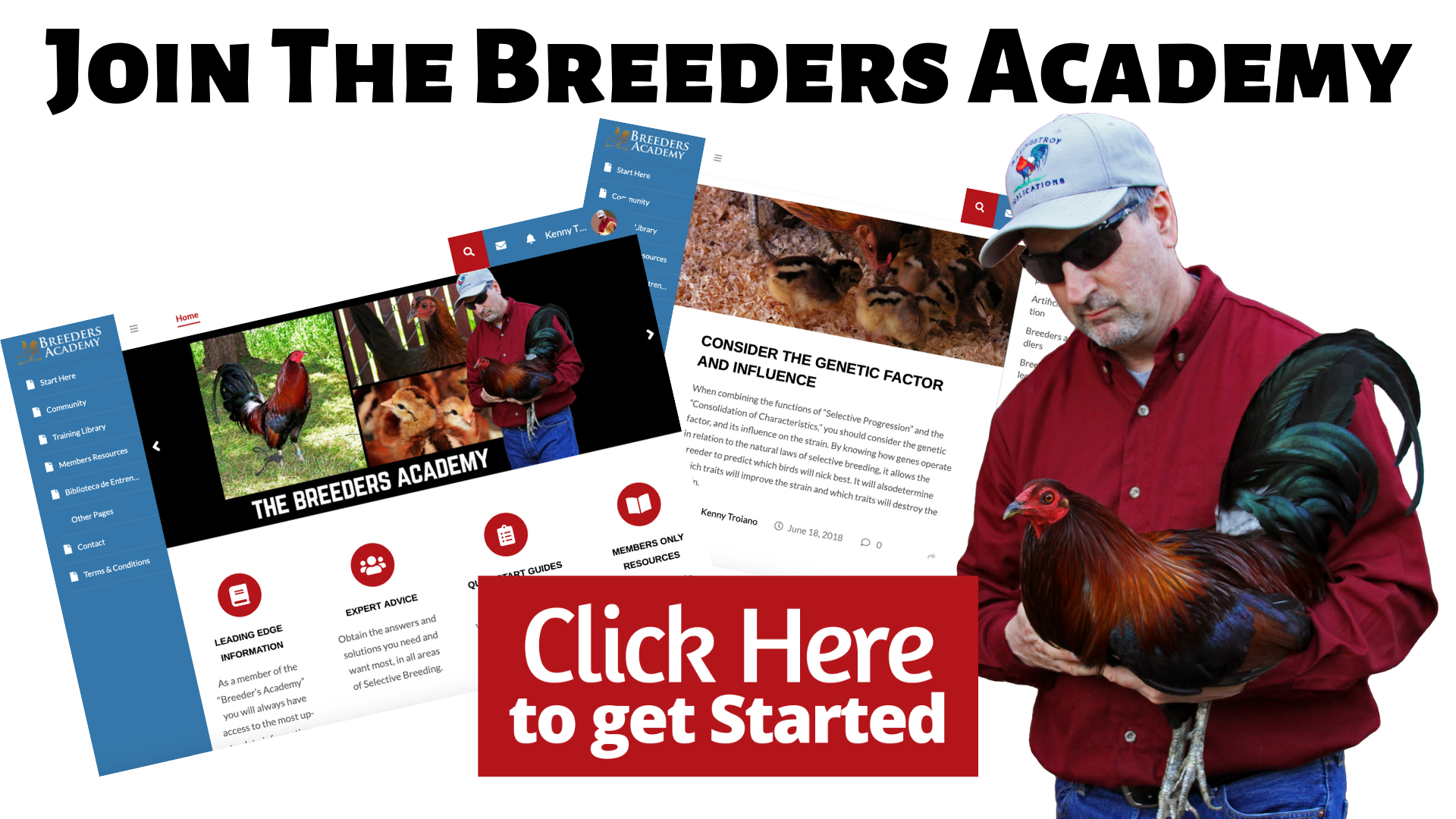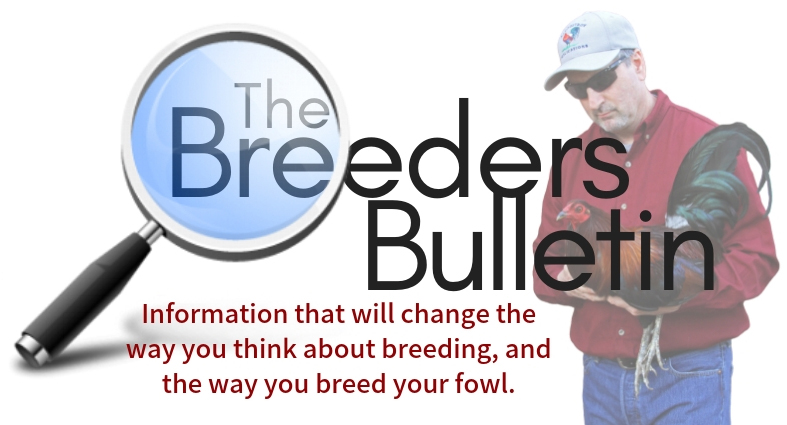Let’s address a belief many breeders share, and that is, it’s better to introduce new blood, rather than create their own strain.
Some breeders believe that in order to keep your strain healthy and strong, and keep them from getting smaller, you need to infuse new blood from time to time. They believe that by breeding “pure” too long, their fowl will begin to come smaller, express more weaknesses and faults, and get sicker easier too. They believe they can improve the weakness and faults by breeding something into them, and then breed it back out.
The truth is, when you add new blood, you add new genes and new traits. You also add new problems. Unless those traits are dominant, you will never breed them out completely. Recessives and polygenic traits will remain within their genome, and will be expressed sooner or later, depending on the bird you mate to them.
There are 3 main methods of adding or infusing new blood – Crossbreeding, Outcrossing, and Infusion. One is used too much, the other used improperly and for the wrong reasons, and the last is completely misunderstood, and does not function like most think.
So, what are some of the problems associated with adding new blood? Whenever you add or infuse new blood, especially in an established strain, you are mixing the genes, it’s a recombination of the gene pool. Every time they add new blood, they are restructuring the DNA of their strain. They are further and further away from becoming a family or remaining a family.
Whenever you add or infuse new blood, you are potentially introducing genetic weaknesses or disease, not to mention, the introduction of lethal genes. Any one of these can ruin a strain, and if enough breeders follow this way of breeding, in time, it can ruin a breed.
If you are adding new blood, every time you mate your birds, all you are creating are mongrels. In time, these birds stop representing their breed, variety or strain. This may be the most dangerous method of breeding.
Maybe the most popular reason for adding new blood is for hybrid vigor. The problem is, too many breeders tend to breed those hybrids, which cannot reproduce their kind.
Can you create a family from hybrids? The answer is yes, that is what I teach at the Breeders Academy, but it takes a well-designed breeding program to achieve that goal. There are many methods a breeder can use to make that happen, but if you are only using one or two, then you will never create a true strain. This is why most breeders fail, they don’t understand the process, they run into problems, or don’t see progress immediately, so they give up and return to their prior breeding practices of adding or infusing new blood. I’m here to tell you, that’s not breeding!
What are some of the misconceptions associated with adding or infusing new blood? There are a handful of misconceptions breeders have about crossing or infusing outside blood into an established strain.
Maybe the most common is that – crossing improves faults or fixes defects. The idea that introducing an apparently superior bird into an established strain can fix a defect or fault, is only possible in a line-breeding program, used over many generations, and by using this superior bird each and every generation. Supposing that bird has no faults of its own, either expressed or hidden within its genome. If you line-breed this bird to this extent, you have changed the genetic make-up of your strain completely. We call this method a “transformation,” not a fix.
The next most common misconception, is that crossing or infusing can improve performance and production ability. The problem with this belief is that traits, such as performance or production ability are QT’s, otherwise known as Quantitative Traits, which are determined by multiple genes, not just one. We call traits that are determined by multiple genes, Polygenic Traits.
These traits are measurable and have different intensities within a strain, which means, no matter the family or strain, no two birds are exactly alike. Each bird has a different intensity than the rest. These traits can only be improved through long term selective breeding, and by selecting the birds with the highest intensity for that trait, and then culling the rest.
Crossing or infusing outside blood only dilutes and weakens that intensity. It sets you back and destroys any progress you have made thus this far. Traits, such as these take many years to create and improve. By breeding to a bird that has a low intensity, or lacks that trait, the offspring will lack that trait as well.
Another common misconception is that – crossing and infusion will fix or improve type and conformation of body. Again, type and conformation are determined by multiple genes. I suggest you read the paragraph prior to this one to understand how they function. It’s the same as performance and production ability.
What are the unintended consequences of adding or infusing new blood? Mixing of breed characteristics – I see this all the time. They will breed an American Game with an Aseel. This changes the offspring completely. They don’t represent American Games or Aseel’s. Even if you breed back to one side, over many generations, they will never represent that breed. They will always be a little different. If that is what you want, fine. Just don’t call them American Games or Aseels.
Mixing of color groups – I see this a lot too. Just look at many of the grey birds. They are not silver duckwing or golden duckwing, they are a dirty or muddy colored bird. They are a grey bird, yes, but with a heavy leakage of red in the wing-bows and saddle feathers. Many breeders don’t understand the consequences of mixing color groups. If you want to maintain or improve the plumage color, never breed a duckwing bird with a self-colored bird, or a crowing-wing bird with a duckwing bird. Also, don’t breed a dominant color with a recessive color.
There’s no endgame to this kind of breeding – The problem with adding or infusing new blood is that once you add or infuse blood, you create such a mess genetically. It will take you years to fix it, or you will, like so many, give up and start adding more outside blood. That is a “merry-go-round ride” that you will never get off from.
To create a strain, every mating must have a purpose, and it must achieve a specific result. If you do not know the result, then don’t breed them. That is why breeding programs are so important. A proper breeding program will take you step-by-step closer to creating a high quality, superior strain.
Why don’t they create a strain? this is a question I’ve been asking for years. It comes down to this – many are scared of the time and devotion it will take to create and improve a strain.
They are also scared of some of the methods that are involved. For example, inbreeding and line-breeding has become voodoo for many breeders. They have been told that these methods have detrimental consequences and should be avoiding at all cost. I’m here to tell you, you cannot create or improve a strain without using inbreeding and line-breeding. Once you understand their importance, and how they function within a breeding program, you will be more comfortable with using them. The problem is, many breeders use inbreeding and line-breeding wrong. They also need to know when to use them, how to use them, and know when to stop using these methods.
I see a lot of breeders confusing line-breeding with backcrossing. These are two methods may seem similar, but are used very differently, and for different reasons.
Another reason they don’t want to create a strain, is that they don’t know how to create a strain. This is what we teach at the Breeders Academy. Once you learn how, you will have this knowledge for life. Knowledge is the best tool in your tool box.
Some don’t attempt to create a strain, because they believe that there is no such thing as a pure strain. I have a program, inside the Breeders Academy, called “Purity of Blood.” This program will walk you through this idea of why it’s real, and why you should embrace these principles and practices.
Last, but not least, they are lazy. There are many breeders that don’t want the hassle, the work, or the thinking that is involved. For most, crossbreeding is the quick fix, the shortcut. I believe that crossbreeding and infusion methods are a waste of time and money. And, when it’s all said and done, what do you have to show for it?
So, what should they do? My advice is to stop adding or infusing new blood, and work towards create a strain. I have a breeding program, called “The Founders Program” that shows you how to take your hybrid crosses, mixed flocks, and mongrel fowl, and turn them into a true strain.
Special Note of interest: The Founders Program will show you how to select your seed fowl, and how to move properly into the transitional stage, and by using a number of breeding methods, at the right time, for the proper length of time, you can create a true foundation strain, one that can last for decades.
We use well-designed and proven consolidation programs, transitional programs, improvement programs, and a preservation program that will show you how to maintain that family well into the future.
This is all available at the Breeders Academy, where I can help you to advance your skills as a breeder, increase your knowledge of breeding, and improve the quality of your fowl. I’m confident, that if you follow my teachings, you will take you and your fowl to the next level.
There’s no such thing as needing to catch up or falling behind. You can go at your own pace, learn what you want, when you want.
You can cancel anytime. And, you have a 30-day, money back guarantee.
So, what are you waiting for? If you are not a member of the Breeders Academy, you are missing out and falling behind.
Join us at the Breeders Academy today, and become a master at breeding.
Benefits of joining the Breeders Academy:
- I will show you how to create, maintain and improve your strains.
- I will show you how to create a strain from hybrid crosses, mixed flocks or mongrels.
- And give you the tools you will need to take your strain to the next level.
- You will learn how to properly use:
- Genetics
- Laws of inheritance
- Selection and culling
- Breeding methods
- Breeding programs
We have great members resources, and I’m there to help you every step of the way. We also do members coaching calls too.
Coaching Call with Jess (Introduction)
This is a coaching call with Jess, who is a member of the Breeders Academy.
She is from New York and is a livestock manager of a 350-acre farm. They raise:
- Cattle
- Sheep
- Pigs
- Goats
- Turkeys
- Meat birds
- And they have a laying hen operation (Rhode Island Reds)
She wants to move from the “all-in/all-out” method to creating and developing their own strains.
In this episode, we are going to help Jess get started on the right foot.

